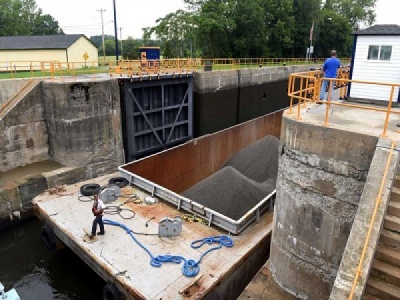
Posted on August 30, 2016
By Rick Karlin, timesunion
The Champlain canal is a 60-mile waterway that runs through the Hudson River north of Troy to Fort Edward, where a General Electric capacitor plant decades ago dumped tons of polychlorinated biphenyls or PCBs into the river.
The canal then becomes a separate waterway dug by 19th-century laborers to connect the Hudson with Lake Champlain.
Currently, the canal sees little more than pleasure boat traffic, but one Troy-based company, New York State Marine Highway, uses it to haul crushed granite on barges from Washington County to New York City, where it is processed into street paving material.
But in terms of heavy commercial traffic currently using the canal, “Pretty much I’m it,” said Marine Highway’s Rob Goldman.
While the granite-hauling keeps Goldman’s tugboats and barges busy, he says that if the canal were to be dredged, he could move even more material. It could also open the waterway to other forms of traffic.
That’s why he, along with environmentalists, were heartened earlier this month when state Environmental Conservation Commissioner Basil Seggos reaffirmed New York’s intention to dredge the canal, which hasn’t been cleared in years and is only a few feet deep in some spots.
His remarks came as part of a public call for the federal Environmental Protection Agency to reassess the deal it struck with GE to complete the PCB dredging, which was ostensibly wrapped up last year.
Seggos and others cited research indicating there still are substantial pockets of PCBs in the river. “The job is not done,” he said last Monday. His remarks suggested that the state could rekindle what had been its years-long legal fight with GE, which ended in a 2002 settlement in which the company agreed to dredge the river between Troy and Fort Edward.
But before any more dredging shovels enter the water, a series of decisions by several stakeholders will have to be made. And they’ll have to figure out who will pay for the job.
The canal is operated by State Canal Corp. Officials there have already applied to the federal Army Corps of Engineers for a dredging permit, which is needed before any work begins.
But with some PCBs left in the river bottom, scooping up sediment becomes a highly technical operation that also requires special facilities such as a “de-watering” plant and a site to put the toxic waste that is removed.
Another potential complicating factor: The Canal Corp. at the end of this year will no longer be a subsidiary of the state Thruway Authority.
It will instead become part of the New York Power Authority, which operates hydroelectric dams, including some along the canal system. Goldman is one of those who think that’s a good move because the Power Authority already has expertise in canal operations.
But since they don’t take control of the Canal until January, Power Authority planners haven’t really broached the dredging issue. Nor is there any money in NYPA’s current budget for dredging, said Authority spokesman Steven Gosset.
For these reasons, Seggos’ remarks about dredging the canal was received with a combination of cheer and skepticism.
Environmental Advocates’ Peter Iwanowicz said, “This is great that they are going to do this.” But “do they have the financial resources to do it, because they are also going to have to dredge contaminated soils.”
“The problem with the Champlain Canal is that PCBs are extremely expensive to (dredge),” added Abigail Jones, a lawyer with Hudson Riverkeeper, which also favors removing any excess PCBs.
It can cost four times as much as a normal “navigational” dredging, which simply aims to deepen a channel for boating and shipping purposes.
Dredging the canal could cost up to $180 million, according to previous estimates.
The Canal Corp. doesn’t have that kind of money on hand: It currently requires subsidies to operate and until this year received support from Thruway tolls to help balance its books.
Environmentalists say GE should pay, since they dumped the PCBs in the first place that made the standard navigational dredging impossible.
But the company insists that it had met the terms of the agreement it reached with the state more than a decade ago.
“GE addressed 100 percent of the PCBs targeted by EPA,” company spokesman Mark Behan said in an email. “EPA concluded the project’s goals were achieved. Navigational dredging was never part of the environmental project. Keeping the Upper Hudson and Champlain Canal navigable is the responsibility of the state Canal Corporation.”
But Seggos sounded adamant.
“We intend to dredge that canal,” he said, “and all of our legal options are on the table as to who pays for it.”
Environmentalists realize it could lead to another protracted court battle.
That would be the most inefficient way of resolving the issue, said Riverkeeper’s Jones.
“But it might be our only option at this point,” she said.
Source: timesunion





